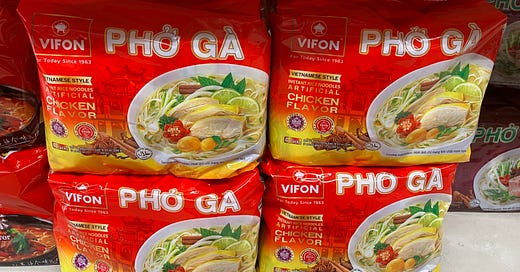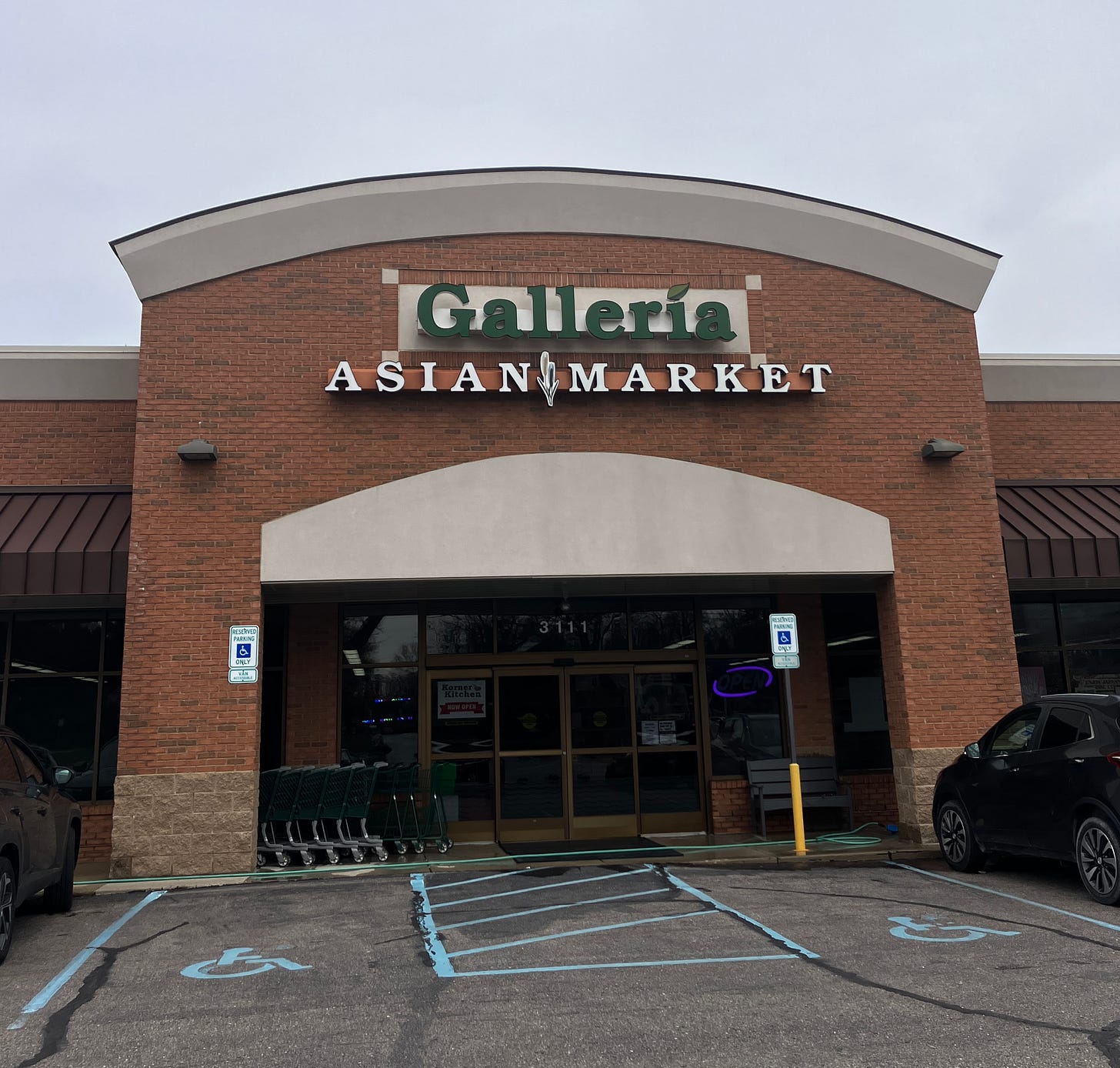Tariffs Send Prices Higher As The Food World Scrambles
Merchants selling imported products will feel the pinch
Hello and welcome to the CulinaryWoman Newsletter! If you’re a newcomer this week, I’m pleased to see you, and hello to returning subscribers.
CulinaryWoman looks at topics in the business world as they relate to food, and there was just one topic that our people were talking about last week: tariffs.
Tariffs Will Touch Every Corner Of The Food World
On Friday, I took a quick drive in my neighborhood, which is populated by shops and restaurants that focus on international cuisine. There are nine such restaurants, coffee shops and markets on the south side of Packard Street, and the big Galleria Asian Market faces them on the north side.
Galleria was especially busy, and I saw people with arms full of products like noodles, sauces, sweets and beverages.
Like many markets, Galleria gets inventory in a few different ways. There are distributors online who specialize in food from Japan, South Korea, Vietnam and elsewhere that populate Galleria’s shelves and refrigerator compartments. In a pinch, the market can order from Amazon, and there are some Asian products stocked at Restaurant Depot and from Sysco.
As far as I could tell, prices hadn’t gone up yet. But anything that’s coming to the U.S. by freighter, truck or cargo plane can expect increases.
On Wednesday, which he dubbed “Liberation Day,” Donald Trump rolled out a long list of tariffs on countries around the world. The tariffs were random — 10% on Yemen, which has become an increasing presence in the coffee world, 20% on European Union members, 34% on Japan and China, 36% on Thailand, and 46% on Vietnam. Canada and Mexico already got their tariffs a few weeks back.
Everywhere I looked in Galleria, it was likely that tariffs would send its prices higher, if the store owners decided to pass along the additional fees.
Some difficult choices
On Cape Cod, the owners of L’Adoro Italian Market in Sandwich, Mass., said the shop would attempt to keep a lid on prices. L’Adoro is a much-loved business. It initially occupied a smaller spot on Route 6A, not far from where my family vacations, and subsequently moved into Russell’s Corner, a post-card worthy spot.
Along with imported products, the market makes grab and go dishes and also conducts tours to Italy.
“Please stick with me through this,” L’Adoro wrote in a Facebook post. “Continue to shop local and shop small. Thank you.”
But at another end of the food world, wine sellers were already anticipating that prices of European wines would go up, and possibly those from Australia, too (the tariff on Australian products is only 10%).
“While intended to boost domestic production, the tariffs may hurt the U.S. wine industry by limiting choices, raising prices, and provoking retaliatory trade actions that could reduce exports of American wines,” Ray Isle, the executive wine editor of Food & Wine, wrote.
“For anyone who loves wine or who works in the wine industry, these tariffs will both reduce consumer choice and in many cases will put American wine businesses in financial jeopardy.”
Jeff Kellogg, a wholesaler in the Carolinas, said he probably would not single out European wines for higher prices. “t’s better for us to raise the price of everything by a small amount to cover this situation,” he told Food & Wine. “If we raised the price even more, on just the imports, those sales would disappear, and we would just be sitting on that inventory.”
China’s packaging clout
Even if you make an effort to eat local, or choose American cuisine over that from overseas, the tariffs will be hard to escape. They affect not only things you consume, but also the packaging in which they are delivered, and the carryout boxes you might request to tote home part of your meal.
In 2023, the U.S. imported $21.2 billion in total plastic products, with about $7 billion coming from China, according to AsiaPack, which tracks packaging topics in Asia. “China's status as the world's manufacturing and packaging hub is not a fluke; it's the result of decades of planning, investment, and hard work,” the report said.
Tariffs could prompt China to speed its Belt and Road Initiative, also known as the New Silk Road. Launched in 2013, China has been building a physical network to link it to East Asia, Europe, Africa, Latin America and other Pacific Ocean countries.
To date, 147 countries— equal to two-thirds of the world’s population and 40% of global GDP—have signed on to projects or indicated an interest in doing so.
It remains to be seen how long the tariffs will last, and whether the protests this weekend and plunge in global stock markets will cause the White House to back track.
But, until they do, you can be sure that they will touch you, and the places where you find food, in some kind of way.
Auctioning A Lifetime In Food Broadcasting
My friend
who publishes the Tip of the Tongue newsletter, reminded me of an auction that is taking place this month in Minneapolis. Lynn Rossetto Kasper,the long-time host of The Spendid Table on Public Radio, is selling much of her culinary memorabilia.The auction is taking place online and will be live on Wednesday, April 16.
Scrolling through the lots, you’ll find a fascinating collection of Lynn’s belongings. They include her 1993 James Beard medal for book of the year, lots of her notes and files, a set of cookbooks signed by Julia Child, and another collection signed by James Beard.
There are some gorgeous copper pots, and stacks of kitchen towels. You can buy etchings, a cast iron dinner bell, teapots, lots of ceramic and china dinnerware, and a pasta maker.
If you love kitchen gear, this is a fantastic opportunity, and as of this weekend, the prices seemed afforable. I actually own the same copper mixing bowl that is in the auction and I’m glad to see the bids for it.
Michelin Is Surveying The American South
For years, people in New Orleans have wondered why that standout food city did not have its own Michelin Guide. The reason most likely was the cost of convincing Michelin to rate its restaurants. Cities and states have paid the French establishment as much as $2 million in incentives to land guides.
Now, Michelin is preparing a guide to the American South. This guide will cover Alabama, Louisiana, Mississippi, North Carolina, South Carolina, Tennessee and the pre-existing Atlanta Guide.
Most likely, economic development officials in those states have pooled their resources to pony up for Michelin, whose official sponsor is TravelSouth, which promotes travel in those states.
The selections for 2025 will be revealed at “a later date,” Michelin said in a news release. It said inspectors were already in the field, assessing possible listings.
As you know from this newsletter, Michelin does not only award stars; it has shifted to a much broader series of ratings that include “recognized” restaurants, and it also gives out Bibendum awards, signifying a good value.
If you’ve watched Emily in Paris, or more recently Grand Maison Tokyo, the Japanese drama, you know that there is much intrigue around the way Michelin reviews restaurants.
While a Michelin lsiting is a valuable marketing opportunity, I wonder whether its prestige is being dulled by the proliferation of newsletters, websites and especially social media surrounding food.
There’s also the added pressure of living up to a Michelin rating, which has prompted some European chefs to back away from being listed.
Northern Michigan Is Walloped By An Ice Storm
Last summer, I told you about my delightful trip to Petoskey, Mich., where I spoke at the Bay View Association. I had the chance to tour around the area, and made some wonderful food finds.
However, several of those new food discoveries took it on the chin last week from a brutal ice storm. The Mackinac Bridge was closed due to falling ice, power lines were downed, roads were iced over and trees came crashing down.
Businesses including Crooked Tree Breadworks, which makes wonderful granola, bread, cookies and pastries, were forced to close for several days.
The storm was a particular challenge for Bear Creek Organic Farm, a beautiful property on the outskirts of Petoskey, which operates a farm market and a food truck that is a popular spot in warm weather.
The farm, which has won numerous awards, hustled to save the plants in its greenhouses and preserve the goods in its store. By the end of the week, the worst was hopefully over, but the farm was left in need of support.
Bear Creek set a Go Fund Me, which blew by its initial $39,000 goal. By Friday, it had raised $75,000 — proof of how much it is valued by its customers. Please check them out if you are visiting Up North this summer on vacation.
Keeping Up With CulinaryWoman
Along with appearing on PBS NewsHour last week, I was invited by WJR Radio in Detroit to talk about the tariff situation. It’s definitely something that is front of mind in the auto industry. Also, my Women Who Lead interview is now up on the WJR website if you’d like to listen.
The Lions, Towers & Shields podcast looked at Dark Victory, the 1939 weepie that starred Bette Davis and George Brent. It made me value the clearer communication that patients have these days with their doctors.
I’m happy to hear from you and have you follow me.
Website: www.michelinemaynard.com
Email: culinarywoman (@) gmail dot com
Threads and Instagram: (@) michelinemaynard
Bluesky: mickimaynard.bsky.social
TikTok: CulinaryWoman
Tomorrow, paid subscribers will receive Red Beans & Advice, a weekly feature that includes my recommendations on things related to food. I’m looking at a very entertaining whodunit on Netflix that takes place where I once had an internship.
Have a good week, and stay calm.










